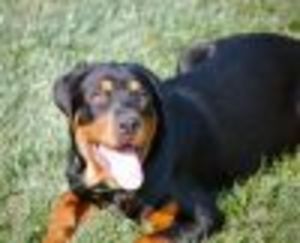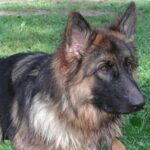“Guard dogs” is too general a term to be definitive. True guard dogs often guard property and patrol premises, like “sentry dogs,” but they don’t make good family pets. An “attack dog,” a genuine “man stopper,” is a potential killer that should be trained by professionals, for professionals, like police.
What most people want when they speak of a guard dog, is a dog that will act as “personal protection,” that is, a dog that will give a warning bark and display a threatening posture.
If you simply want a warning barker, an “alarm dog” may be enough for you. Most dogs are natural barkers; they will sound a warning bark at most strangers. Even small dogs make good alarm dogs, but they won’t try to “protect” you. From the Affenpinscher to the Yorkie, size doesn’t matter for this job.
Beyond simply watching and barking, a dog that acts as a “threat dog” will offer personal protection with physical threats to intruders. These dogs should be trained by a professional when they are about six months old. A natural guard dog has better judgment than an attack-trained dog, which can be quite dangerous and more of a liability than an asset. Some breeds are better choices for family protection.
Protection Dogs aka “Threat Dogs”
Most people want a “protection dog” that will defend its family by jumping, snarling, seizing or chasing – not biting, seriously injuring or killing. The following breeds have shown themselves to be great guardians and protectors. Most can also make wonderful family pets – with proper training and with experienced dog owners who aren’t intimidated by their size and power.
Boxers are fine protectors. These dogs are fun-loving with adults and children, although wary of strangers. This breed seems to be able to read peoples’ characters and intentions. They are usually great with kids. Some people adore boxers, but they will tell you this breed tends to be gassy and might not make good bedroom or TV viewing companions.
Doberman Pinschers have been selectively bred for protection and will instinctively protect their human pack members. A Dobie will alert his master of suspicious activity, but he is also willing-and-able to use his teeth in defense. Dobermans are also a good choice for guard and Schutzhund trainers who teach attack training.
These dogs respond well to love and praise, but not heavy-handed discipline. Some are sweet and submissive, and good with children and other pets if raised with them, but they can be quite aggressive with other dogs.
I worked with several dog trainers as a dog rescuer. Two trainers adopted Dobermans (sisters) that had been puppy mill dogs, which they had rescued. Both dogs snarled at me; both trainers warned me “not to touch her toy” and “not to go near her food while she was eating” (Do I look like an idiot?). If you love dobies, you had better be an experienced dog owner and very experienced at playing the pack leader.
German Shepherds are probably the American “poster dogs” as protectors/guardians. Everyone knows what a Shepherd looks like. (Remember Rin Tin Tin?) These (well-bred) dogs make fine pets and are great with kids. They are intelligent, loyal and alert.
Giant Schnauzers make great police and military dogs, and they are well respected by Europeans. These dogs are becoming more popular in the U.S., since they have such a distinguished look (with eyebrows and beards), and they make good family pets. They must be socialized early to children, strangers and other pets. Some are very aggressive.
Great Danes make great guard dogs just by standing still and barking. Well-bred, well-trained Danes make great family pets. They can deter the unwanted with a look.
These dogs are eager to please, easy-going, and friendly, but often act shy towards strangers. These dogs do not respond well to heavy-handed treatment, and should not be encouraged to play tug-of-war games. Some are heavy droolers. They were used in Germany to hunt wild boar.
I visited the home of a Dane rescuer who owned (and fostered) four dogs at a time. She also had three young children. While we were sitting at the table, the dogs surrounded us, sitting and looking at us from eye-level. When one got overly excited, the owner made her leave us and sit on the other side of a glass door; once she calmed down she was allowed to re-join the group.
This was one eye-opening experience into the world of dogs as well-behaved companions, with a true pack leader that kept boundaries and limitations. These dogs deserve no less.
Mastiffs are one of the most intimidating breeds of dogs because of sheer size, up to 200 pounds and more. Mastiffs don’t give warning barks; they simply knock down intruders and pin them to the ground.
They love children and get along well with other animals. They are usually friendly-but-reserved with strangers.
I re-homed two mastiffs to experienced dog owners who showed no fear and knew what they were doing. Most of these dogs are droolers. Be ready to deal with that trait. These dogs have only to look at you to make you freeze in your tracks. These are not for inexperienced dog owners.
Rottweilers are another popular breed, but, perhaps, they have been over bred. A well-trained Rottie can be a wonderful protector/guardian, but these dogs are known for a high-bite rate so owners really should know what they’re getting. They can be an insurance liability. They cannot always be trusted with other dogs or cats.
Cesar Millan, the “Dog Whisperer,” bestows great praise on these dogs as a powerful breed that needs a strong pack leader. Cesar says he always keeps a few Rotties on hand, and he knows his family will be safe until he gets back from his travels.
Gopetsamerica.com also “recommends” Airedale Terriers, American Bulldogs, Beaucerons, Belgian Malinois Sheepdogs, Bouvier des Flandres, Briards, Chows, and the Siberian Husky as other guard dog possibilities.
The Siberian Husky usually adores children and may do OK with other dogs, but not so well with cats.
My neighbor had a Husky, which was one intimidating dog, with the easily-recognizable wolf face. When she divorced, she kept the dog. Without the male “pack leader,” Zona became so protective of her that she couldn’t have visitors in, and the borough would make her take him indoors before they would read the outside water meter. Ditto for the gas man.
Zona was contained by an “invisible” electric fence, which worked great as long as his collar-batteries worked. But people didn’t know he was “contained,” and they didn’t want to come to our in-home shop because he appeared to be loose. We probably lost some customers over that, but we also felt a bit “protected” because few intruders would attempt to enter our house either, with him just a few feet from the invisible property line.
I have to disagree with the Gopetsamerica.com Chow Chow recommendation — for most families. Two vets told me Chows were simply too unpredictable for most people, and neither vet “trusted” the breed completely. One vet said he usually muzzled Chows before working on them. Again, it seems to be a problem with over-breeding.
The Chow is quiet and independent, a one-person dog. It will tolerate children if raised with them, “but will not be playful.”
I re-homed one purebred Chow. The original owner was confident around the dog and so were her adult girls. I watched them interact easily with the dog and even kiss it on the face. It took two tries to find the right home. The first adopter lost confidence and became fearful, which the dog sensed. Ultimately, I found a home with a groomer who had experience and confidence with the breed.
Anyone looking for a protection/guard dog can begin with the above list. As always, the background, training, and socialization of the dogs involved are important in making decisions. I dealt with rescued dogs that had lived with families, but needed to be re-homed through no fault of their own.
If you want a purebred, the onus falls on the breeder to be good, reliable, and trustworthy. Most reputable dog breeders adore their dogs and do right by them. Try to meet the “parent” dogs; have the whole family interact with the dog of your choice; and introduce your other dogs to the potential newcomer. If you’re a cat owner, you should inquire about how an adult dog reacts around cats. Puppies often adapt better to cats – and children – as home companions by growing up with them.
Make sure all dogs and family members get along before taking the dog to its permanent home. It does not usually work out if the “man of the house” can play the alpha dog and his wife can’t. It can become a choice between wife or dog.
If you’re choosing a protection dog, do your homework on the breed; plan to get the dog some basic obedience training; and make sure you can properly exercise and care for a powerful breed. You should have a great 10 to 15 years together if you’re all properly prepared to be the pack leaders.
Sources:
www.gopetsamerica.com. “Guard Dogs.” Alarm, sentry, attack and protection dogs. Retrieved 2-14-10.
ASPCA Complete Guide to Dogs. Sheldon Gerstenfeld, V.M.D. Chronical Books, 1999. Includes notations on most of the recommended breeds listed.
Personal experience as a dog rescuer.




